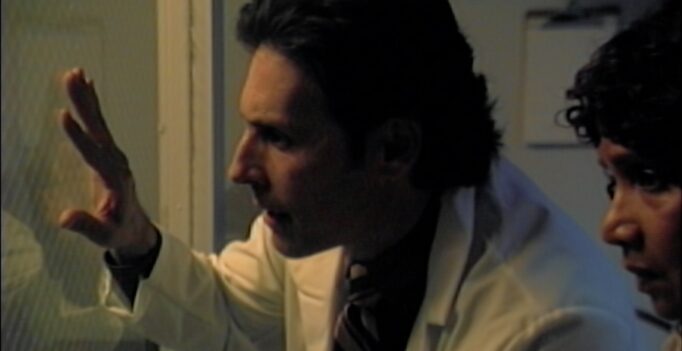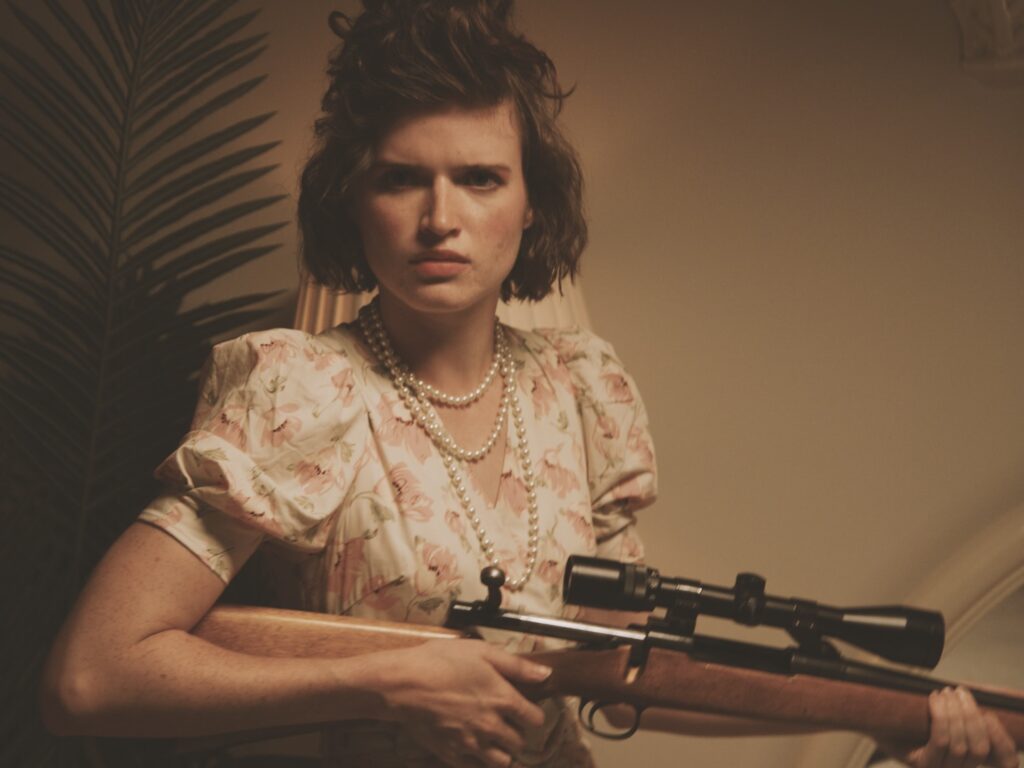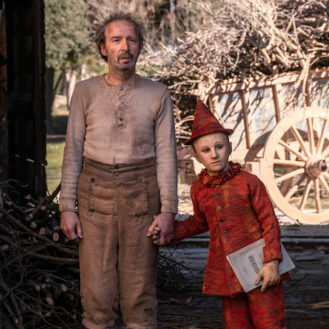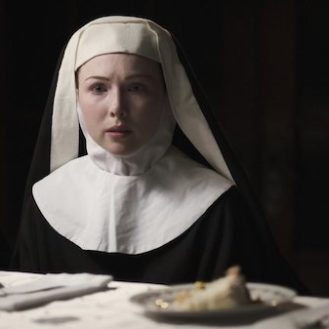Shannon Page’s coverage of this year’s Vancouver Horror Show Film Festival (VHS) concludes with reviews of two spooky features – Faceless After Dark and V/H/S/85.
Faceless After Dark (DIR. Raymond Wood)
Get ready to get meta with the latest horror from Raymond Wood (1st Summoning). Jenna Kanell (Terrifier and Terrifier 2) co-wrote the script for this surreal, twisted tale about an actress from a killer clown horror movie (Kanell) who is stalked by a psychotic fan in a clown mask — giving whole new meaning to the phrase “write what you know”. One part gender-flipped American Psycho, one part home invasion flick, and three parts seizure-inducing strobe lights, Faceless After Dark is the sort of movie that manages to be disturbing, cathartic, thought-provoking, and wildly entertaining all at the same time.
Though she begins as the victim of a menacing home invasion, Bowie quickly turns the tables on her would-be tormentor. As the film progresses, she discovers her own capacity for violence and revenge, sinking deeper into her own twisted psyche in the process.
But, for as terrifying as she is, one of my favorite aspects of Faceless After Dark is that Bowie never becomes the monster of the film, not completely. That role belongs to her trauma, and the men (and women) who have caused it. In fact, Bowie herself is sympathetic and vulnerable, even when dripping in blood and wielding a machete. Much of the credit belongs to Kanell, who delivers a raw, emotional, and layered performance. In a particularly memorable scene near the climax of the film, the camera focuses on Bowie’s face for several long minutes as she moves from pain to horror to laughter, emotions rolling through her like shockwaves while the viewer is trapped in place (much like Bowie’s victims) and forced to witness her catharsis whether we want to or not.
Bowie is also an unapologetically queer character, and Faceless After Dark is an unapologetically queer film. As we see Bowie take on different roles (victim, monster, femme fatale) we also see her gender presentation shift and evolve. This feels like both an outward expression of the character’s occupation (she is an actress and playing a “role” is what she does) as well as a reflection of her inward, personal journey as a person who does not conform to societal expectations of gender expression or sexual orientation. Bowie challenges our usual assumptions of gender and genre, deliberately defying easy classification and blurring the line between victim/perpetrator, predator/prey, monster/final girl, and even artist/subject.
There’s also blood, gore, and clever one-liners to satisfy hardcore fans of the horror genre. That Faceless After Dark can be both laugh-out-loud funny and genuinely distressing is a testament to the immense talent on display both in front of, and behind, the camera.
For me, this just might be the best movie of the year — regardless of genre. For horror fans, it’s unmissable. Make sure to catch Faceless After Dark on the big screen, if you can, to experience the maximum impact of the dizzying visuals that illuminate Bowie’s surreal inner world.
Faceless After Dark is still making its rounds on the festival circuit. Keep your eyes peeled on your local listings.
V/H/S/85 (DIR. David Bruckner, Scott Derrickson, Natasha Kermani, Mike P. Nelson, Gigi Saul Guerrero)
The V/H/S series has always been inconsistent when it comes to quality, but a certain amount of variation is to be expected with any anthology. It comes with the territory: multiple directors means that multiple styles and approaches to filmmaking are all coming together into one film. V/H/S/85, the sixth instalment in the long-running found-footage horror series which began with V/H/S (2012), is a bumpy ride — and not all of it is the fun kind.
As the title suggests, the instalment is a throwback to the 1980s. The framing segment, “Total Copy” directed by David Bruckner (The Ritual, The Night House, 2022’s Hellraiser) and written by Evan Dickson, is divided into fragments that open and close the film. “Total Copy”, which takes the form of a made-for-television documentary in which scientists experiment on a shapeshifting life form, is one of the stronger installments in this anthology and acts as a bridge between the other segments. The result is a bit like watching a television documentary that someone has taped onto a VHS tape — only to have it taped over with bits and pieces of other things (home video, television news segments, police video footage) over time. Some segments, like “God of Death”, written and directed by Vancouver-based Mexican filmmaker Gigi Saul Guerrero (Bingo Hell), are shot on VHS, lending a fun twist of authenticity to the proceedings.
The other stand out segments are “No Wake” and “Ambrosia”, both written and directed by Mike P. Nelson (2021’s Wrong Turn, The Domestics). Though they could each function as standalone pieces, taken together they form two halves of the same horrifying story — told from two very different perspectives. In the first, a group of friends are out on a camping trip and enjoying themselves in the lake, but things take a strange and violent turn when they become the target of an unknown shooter. In “Ambrosia”, a young woman and her family prepare for her coming-of-age party. Both shorts make thoughtful use of the home-video form, asking interesting questions about perspective, narrative, and fear.
“TKNOGD”, directed by Natasha Kermani (Imitation Girl, Lucky), also deserves a shout out. Technology and the digital world can be rich ground for horror. This segment is worth watching for Chivonne Michelle’s performance alone. Featuring a performance artist (Michelle) who challenges the boundary between the digital and the physical, things get weird enough that you’ll never look at a VR headset quite the same way again.
Though I love to root for hometown talent, “God of Death” was the least memorable part of the anthology for me. While I enjoyed the depiction of claustrophobia (an under-explored theme in horror), and the setting of the 1985 Mexico City earthquake gave the events an extra layer of real-life significance, it felt rushed and underdeveloped. I wonder if perhaps this idea would have been better suited to a longer format that the provided the necessary room to explore the nuance and complexity of the material.
Overall, V/H/S/85 is a strong installment in the franchise. The framing device is coherent, and it makes for a more cohesive and immersive watching experience than some of the earlier instalments. This alone makes it one of the more accessible V/H/S films for newcomers to the series and folks less familiar with the anthology format.
V/H/S/85 is now streaming on Shudder.
**********
For more information on the festival and its travelling road show, visit the official Vancouver Horror Show Film Festival website.
Do You Tweet? Follow These Tweeple:
Shannon Page: @ShannonEvePage







Be the first to comment